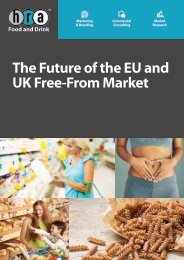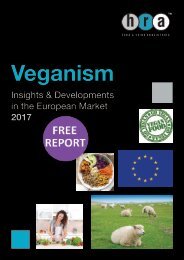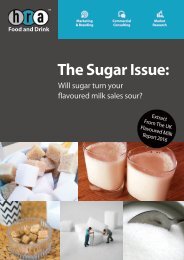Flavoured_Milk_Free
The backdrop to the UK flavoured milk market is one of relentless change. The removal of the EU milk quotas, the transition by emerging economies to a Western-style diet, the upcoming introduction of the ‘sugar tax’ and the booming sports nutrition industry are all aspects of change that create both challenges and opportunities for the UK flavoured milk market. HRA Food and Drink has developed this report as a map to guide industry stakeholders. Although volume growth in 2014 was slightly lower than in previous years, the flavoured milk market still has plenty of room for product innovation in the future.
The backdrop to the UK flavoured milk market is one of relentless change. The removal of the EU milk quotas, the transition by emerging economies to a Western-style diet, the upcoming introduction of the ‘sugar tax’ and the booming sports nutrition industry are all aspects of change that create both challenges and opportunities for the UK flavoured milk market.
HRA Food and Drink has developed this report as a map to guide industry stakeholders. Although volume growth in 2014 was slightly lower than in previous years, the flavoured milk market still has plenty of room for product innovation in the future.
Create successful ePaper yourself
Turn your PDF publications into a flip-book with our unique Google optimized e-Paper software.
UK FLAVOURED MILK MARKET 2017 & BEYOND<br />
6.2.2 Protein over-consumption<br />
Protein drink manufacturers must be aware that that exceedingly high levels<br />
of protein intake could be linked to the development of chronic diseases.<br />
However, this is a controversial debate, with arguments for and against the<br />
health benefits of high protein flavoured milks.<br />
Arguments against excessive<br />
protein consumption<br />
Foods rich in protein i.e. meat and<br />
dairy, are often high in saturated fat.<br />
Kidneys can be harmed by too much<br />
protein.<br />
The defence for<br />
protein drinks<br />
There is evidence that saturated fat is not<br />
as unhealthy as once thought.<br />
Research suggests excessive protein<br />
consumption only exacerbates existing<br />
kidney conditions.<br />
Filling up on protein means eating less<br />
vegetables, fruits and wholegrains.<br />
This could result in nutrient<br />
deficiencies.<br />
Protein drinks are not intended as longterm<br />
meal replacements and are only<br />
recommended as part of a healthy diet.<br />
To view please<br />
purchase full report<br />
Consuming high levels of protein<br />
means more calcium is excreted from<br />
the body, leading to calcium<br />
deficiencies.<br />
Excess protein is converted to fat in<br />
the body so can result in weight gain<br />
Excessive protein consumption can<br />
raise the risk of hyperaminoacidemaia,<br />
and hyperinsulinemia nausea.<br />
Protein from dairy sources contains<br />
calcium.<br />
Products are aimed at active consumers<br />
so weight gain should not be an issue.<br />
Protein drinks only offer a fraction of the<br />
daily limit and, as long as they are used<br />
responsibly are safe.<br />
Figure 6.7: Arguments for and against consuming high protein products<br />
Demographic Age (years) Reference intake (g)<br />
Infant 0-1 9-11g<br />
Child 1-8 13-19g<br />
Male 9-13 34g<br />
Male 14+ To view please 56g<br />
Female purchase 9-13 full report 34g<br />
Female 14+ 46g<br />
Pregnancy/ lactation - 71g<br />
Strength athletes - 1.2-1.7g/kg bodyweight<br />
Endurance athletes - 1.2-1.4kg/kg bodyweight<br />
Figure 6.8: Differing recommended daily protein intakes by demographic (US Food<br />
and Nutrition Board, 2002).<br />
65<br />
© 2016 Teepee Limited. All Rights Reserved.







